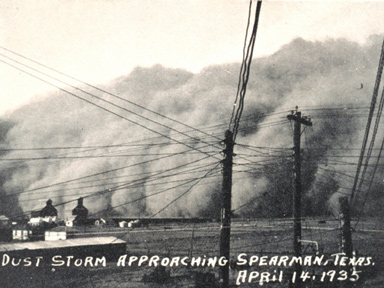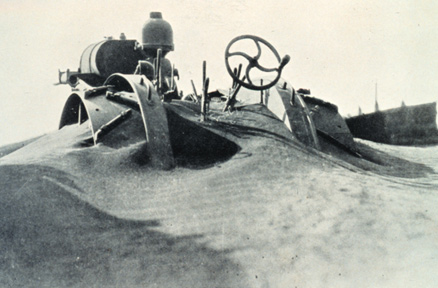|

DESCRIBE WAYS THE BIOSPHERE IMPACTS THE CLIMATE AND WEATHER.BiosphereAlthough we often think of the impact that climate and weather have on the biosphere, especially on us, we don't always remember that the biosphere has an impact on climate and weather. As you know, humans are part of the biosphere, as are all living things. Human actions can impact the weather and climate. Let's look at an example of human impact on weather. Dust bowl
By the early 1900s, the American Midwest was lightly populated with settlers who had discovered that the grasslands had rich soil that was capable of producing good wheat crops. What the farmers did not understand was that weather can be cyclical. Factors such as El Niño can temporarily increase rainfall in an area. Because the Midwest received more rainfall than normal during this time, farmers reaped exceptional harvests. At just about that same time, the tractor was invented. Suddenly farmers could plow up thirty acres a day of virgin prairie sod. Instead of farming eighty acres a year, a farmer could now farm several hundred acres at a time. The future looked bright for the American farmer and more and more sod was plowed up. Then disaster struck. The area reverted back to its normal rainfall and the fields dried up. When the plains were covered with prairie grass, the normal low rainfall did not have a disastrous impact on the area, but without the stabilizing influence of the prairie grass, the climate had changed. The winds that had always blown the prairie grasses now blew the loose, rich dirt and filled the air with raging dust storms. It was not long before the area became known as the dust bowl. J.R. Davison grew up on the prairie and described the dust storms.
“It was in the early '30s, and the first thing we knew, back in the northwest we could see this low cloud bank, it looked like. You could see it all the way across. And we watched that thing and it got closer and seemed to kinda grow, you know. It was gettin' closer. The ends of it would seem to sweep around. And you felt like, you know, you were surrounded. Finally it'd just close in on you, shut off all light. You couldn't see a thing. The first one or two that happened, people thought the end of the world had come. Scared 'em to death. Travelers comin' down the highway didn't know what to do. They were just hysterical…I remember our—our home... it just nearly covered it up.”1 The dust storms became frequent and their devastation lasted for many years. New farming techniques were developed to help solve the problem, but for a long time many farmers did not use them. Eventually, the US government started offering incentives, like paying the farmers $1.00 an acre if they would use the new techniques. Most farmers were so desperate by then that they were willing to try the new methods so they could at least earn a $1.00 an acre. Over time, the worst of the dust storms dissipated, but scientists say that the long-term impact of such massive erosion can never be undone. Footnotes 
|
About Us | Terms of Use | Contact Us | Partner with Us | Press Release | Sitemap | Disclaimer | Privacy Policy
©1999-2011 OpenLearningWorld . com - All Rights Reserved



